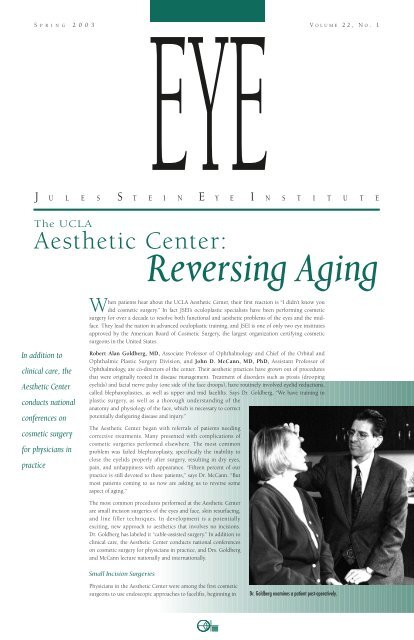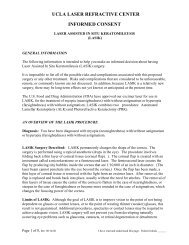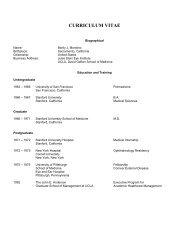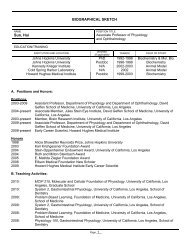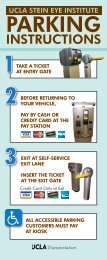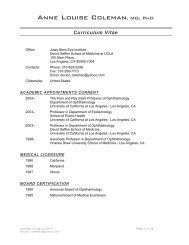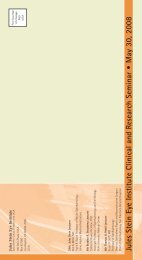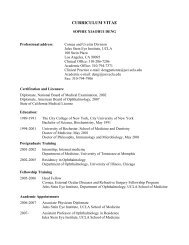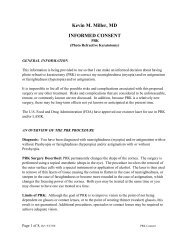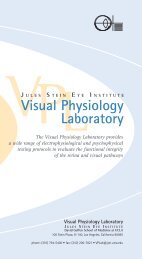Create successful ePaper yourself
Turn your PDF publications into a flip-book with our unique Google optimized e-Paper software.
S P R I N G 2003<br />
EYE<br />
V OLUME 22, NO . 1<br />
J U L E S S T E I N E Y E I N S T I T U T E<br />
The UCLA<br />
Aesthetic Center:<br />
In addition to<br />
clinical care, the<br />
Aesthetic Center<br />
conducts national<br />
conferences on<br />
cosmetic surgery<br />
for physicians in<br />
practice<br />
When patients hear about the UCLA Aesthetic Center, their first reaction is “I didn’t know you<br />
did cosmetic surgery.” In fact JSEI’s oculoplastic specialists have been performing cosmetic<br />
surgery for over a decade to resolve both functional and aesthetic problems of the eyes and the midface.<br />
They lead the nation in advanced oculoplastic training, and JSEI is one of only two eye institutes<br />
approved by the American Board of Cosmetic Surgery, the largest organization certifying cosmetic<br />
surgeons in the United States.<br />
Robert Alan Goldberg, MD, Associate Professor of Ophthalmology and Chief of the Orbital and<br />
Ophthalmic Plastic Surgery Division, and John D. McCann, MD, PhD, Assistant Professor of<br />
Ophthalmology, are co-directors of the center. Their aesthetic practices have grown out of procedures<br />
that were originally rooted in disease management. Treatment of disorders such as ptosis (drooping<br />
eyelids) and facial nerve palsy (one side of the face droops), have routinely involved eyelid reductions,<br />
called blepharoplasties, as well as upper and mid facelifts. Says Dr. Goldberg, “We have training in<br />
plastic surgery, as well as a thorough understanding of the<br />
anatomy and physiology of the face, which is necessary to correct<br />
potentially disfiguring disease and injury.”<br />
The Aesthetic Center began with referrals of patients needing<br />
corrective treatments. Many presented with complications of<br />
cosmetic surgeries performed elsewhere. The most common<br />
problem was failed blepharoplasty, specifically the inability to<br />
close the eyelids properly after surgery, resulting in dry eyes,<br />
pain, and unhappiness with appearance. “Fifteen percent of our<br />
practice is still devoted to these patients,” says Dr. McCann. “But<br />
most patients coming to us now are asking us to reverse some<br />
aspect of aging.”<br />
The most common procedures performed at the Aesthetic Center<br />
are small incision surgeries of the eyes and face, skin resurfacing,<br />
and line filler techniques. In development is a potentially<br />
exciting, new approach to aesthetics that involves no incisions.<br />
Dr. Goldberg has labeled it “cable-assisted surgery.” In addition to<br />
clinical care, the Aesthetic Center conducts national conferences<br />
on cosmetic surgery for physicians in practice, and Drs. Goldberg<br />
and McCann lecture nationally and internationally.<br />
Small Incision Surgeries<br />
Reversing Aging<br />
Physicians in the Aesthetic Center were among the first cosmetic<br />
surgeons to use endoscopic approaches to facelifts, beginning in<br />
Dr. Goldberg examines a patient post-operatively.
THE UCLA AESTHETIC CENTER: Reversing Aging continued<br />
Before and after photographs show<br />
the results of small incision surgery<br />
of the upper and lower eyelids, and<br />
skin resurfacing using a TCA<br />
chemical peel.<br />
EYE<br />
NEWSLETTER<br />
IS APUBLICATION<br />
OF THE<br />
JULES STEIN EYE INSTITUTE<br />
D IRECTOR<br />
Bartly J. Mondino, MD<br />
E DITORS<br />
Debora B. Farber, PhD, DPhhc<br />
Gary N. Holland, MD<br />
M ANAGING E DITOR<br />
Gloria P. Jurisic<br />
S ENIOR E DITOR<br />
Barbara L. Pawley<br />
C ONTRIBUTING E DITORS<br />
Angela D. Aigner<br />
Teresa Closson<br />
Debbie Sato<br />
Irene Siu<br />
Patti Thayer<br />
P HOTOGRAPHY<br />
J. Charles Martin<br />
D ESIGN<br />
Robin Weisz /Graphic Design<br />
P RODUCTION C OORDINATION<br />
Coniglio & Associates<br />
©2003, by The Regents of the University<br />
of California.<br />
All rights reserved.<br />
<strong>Jules</strong> <strong>Stein</strong> <strong>Eye</strong> <strong>Institute</strong><br />
100 <strong>Stein</strong> Plaza, UCLA<br />
Box 957000<br />
Los Angeles, CA 90095–7000<br />
(310) 206-6035<br />
www.jsei.org<br />
the early 1990s. Small incision surgeries currently performed<br />
on a routine basis include forehead or brow lifts, upper and<br />
mid face lifts, and upper and lower blepharoplasties.<br />
Oculoplastic surgery has always had a tradition<br />
of small incision surgeries because of the nature<br />
of the training pathway, which begins with<br />
ophthalmology. Dr. Goldberg explains, “With<br />
the eye, you have a limited space to operate.<br />
Every procedure requires detailed, delicate work<br />
that is critical to both a successful medical outcome<br />
and to the patient’s satisfaction with the<br />
way he or she looks and feels.”<br />
Drs. Goldberg and McCann suggest that the field<br />
of facial cosmetic surgery is moving away from<br />
large, open procedures that carry significant risks<br />
and require long recovery periods. This trend is<br />
driven in part by patients who want more<br />
immediate results and less “down time,” and<br />
are opting to rehabilitate their faces as soon as<br />
they begin looking older. At the same time, the<br />
field of cosmetic surgery is evolving rapidly,<br />
making available procedures that are safer, faster and more<br />
sophisticated. In just the last five years, the field has been<br />
revolutionized. “We are now doing some lower blepharoplasties<br />
without an incision, using a needle to pull out fluid and<br />
sculpt the fat,” Dr. Goldberg explains.<br />
Skin Resurfacing<br />
The focus of skin resurfacing in the Aesthetic Center is nonablative<br />
(working below the surface of the skin), and is often<br />
done in conjunction with small incision surgery. Nonablative<br />
lasers, for instance, work by stimulating the collagen production<br />
and redistributing the tissue in the dermis, leaving the<br />
epidermis (the outer layer of the skin) intact. This approach<br />
has dramatically less risk of scarring and pigment change, and<br />
minimal down time as compared to more aggressive practices.<br />
Other nonablative procedures performed at the Aesthetic<br />
Center include pulse-light therapy and TCA (trichloroacetic<br />
acid) chemical peel. These approaches improve the quality and<br />
clarity of the skin and smooth fine lines. Says Dr. McCann,<br />
“Nonablative skin resurfacing has three goals: eliminate age<br />
spots; eliminate tangelatasias (dilated blood vessels) that cause<br />
skin redness; and eliminate wrinkles. We have accomplished<br />
the first two goals and are close to a full resolution of the last,<br />
most resistant aging problem—wrinkles.”<br />
Line Filler Techniques<br />
Line filler techniques are applied with injections and done as<br />
office procedures, requiring no anesthesia or sedation. Botox<br />
(botulinum toxin), which was approved for cosmetic purposes<br />
in 2001, was originally developed by ophthalmologists to treat<br />
blepharospasm (spasm of the eyelids). JSEI faculty were<br />
involved in the first clinical trials for this purpose. Utilization<br />
of Botox for cosmetic purposes began at the <strong>Institute</strong> in the<br />
early 1990s. Dr. McCann explains, “Some wrinkles are a<br />
result of sun damage and no amount of Botox will resolve<br />
them, but many wrinkles, especially those around the eyes<br />
and on the forehead, are created by constant movement of<br />
the muscles over time. When something, Botox for instance,<br />
stops the muscle from contracting, the wrinkles diminish and<br />
sometimes even disappear.” This effect can be sustained with<br />
periodic injections.<br />
Collagen is a line filler of long-standing use in cosmetic<br />
practices. Its effect is created by introducing collagen, a<br />
natural substance found in healthy skin, into the wrinkles,<br />
usually around the eyes or mouth, plumping and diminishing<br />
them. A new more improved line filler called hyaluronic acid<br />
is similar to collagen, but has a longer life and superior effect.<br />
Dr. McCann treats a patient with pulse-light therapy, a nonablative skin<br />
resurfacing technique for the treatment of acne rosacea (skin redness).<br />
On the market, it is known as Perlane or Restylane. In a<br />
different preparation, hyaluronic acid is routinely used in<br />
ophthalmic surgery to fill the eye during surgical maneuvers.<br />
Fat transfer is the only permanent line filler. Fat is drawn from<br />
one part of the body and injected into the wrinkles. However,<br />
it has not yet been perfected. Dr. Goldberg began researching<br />
fat transfer during his own training as an oculoplastic surgeon<br />
and continues to explore its use, maintaining that once<br />
perfected, it holds the most promise as a line filler.<br />
Cable-Assisted Surgery<br />
The Aesthetic Center is currently researching what may<br />
become a new paradigm for facelifts. Dr. Goldberg calls it<br />
“cable-assisted surgery” because it employs a number of<br />
special threads or cables that act as scalpels, cutting, lifting,<br />
and separating the tissues. Each cable has a different function.<br />
All are inserted through needle incisions. Like the first<br />
refractive surgeries, this treatment approach was pioneered<br />
in Russia. Still in its infancy, cable-assisted surgery offers a<br />
fascinating alternative to incision surgery.<br />
Looking as Good as You Feel<br />
Patient education is a key component of cosmetic surgery. The<br />
Aesthetic Center offers complimentary consultations to people who<br />
want to know more about facial aging or are<br />
considering cosmetic surgery. Danica<br />
Fiaschetti, COA, a certified ophthalmic<br />
surgical assistant, is available for consultation<br />
by appointment. Additionally, several times<br />
throughout the year the Aesthetic Center<br />
offers informative, faculty lectures on aging,<br />
and ways to counter aging. They are free<br />
and open to the public. The next lecture,<br />
Aesthetic Consultant “Looking as Good as You Feel,” will be<br />
Danica Fiaschetti, COA<br />
offered April 29, 2003, at the <strong>Jules</strong> <strong>Stein</strong><br />
<strong>Eye</strong> <strong>Institute</strong> RPB Auditorium. Information<br />
about either of these educational opportunities can be obtained by<br />
calling (310) 794-9341.
Academic News & Views<br />
A NNUAL P OSTGRADUATE S EMINAR AND<br />
T HIRTY-FOURTH J ULES S TEIN L ECTURE<br />
<strong>Jules</strong> <strong>Stein</strong> <strong>Eye</strong> <strong>Institute</strong> and the UCLA Department of<br />
Ophthalmology will hold the Annual Postgraduate Seminar<br />
and Thirty-Fourth <strong>Jules</strong> <strong>Stein</strong> Lecture on April 25–26, 2003,<br />
in the <strong>Institute</strong>’s RPB Auditorium.<br />
The seminar, entitled “Four Careers in UCLA Retina: A<br />
Celebration of Excellence,” will be hosted by the Retina<br />
Division and the UCLA Retina Alumni Association. This year’s<br />
program will acknowledge the extraordinary careers of<br />
Norman E. Byer, MD, Clinical Professor of Ophthalmology<br />
and volunteer faculty member; Robert Y. Foos, MD,<br />
Professor Emeritus of Pathology and Laboratory Medicine;<br />
Allan E. Kreiger, MD, Professor of Ophthalmology and<br />
former Chief of the Retina Division; and Bradley R.<br />
Straatsma, MD, Professor Emeritus of Ophthalmology and<br />
Founding Director of the <strong>Jules</strong> <strong>Stein</strong> <strong>Eye</strong> <strong>Institute</strong>.<br />
The <strong>Jules</strong> <strong>Stein</strong> Lecture will be presented by Stanley Chang,<br />
MD, Edward S. Harkness Professor of Ophthalmology and<br />
Chairman of the Department of Ophthalmology at Columbia<br />
University.<br />
F OURTEENTH A NNUAL<br />
R ESEARCH AND A LUMNI D AY<br />
S EVENTH A NNUAL P OST-ARVO SEMINAR<br />
The Department of Ophthalmology will hold its annual<br />
Research and Alumni Day and Post ARVO Seminar on<br />
Saturday, May 31, 2003, in the RPB Auditorium of the <strong>Jules</strong><br />
<strong>Stein</strong> <strong>Eye</strong> <strong>Institute</strong>.<br />
JSEI’s ophthalmology resident and fellow physicians and<br />
alumni gather each spring to present current clinical research<br />
as part of Research and Alumni Day, while the <strong>Institute</strong>’s<br />
vision science fellows and faculty present the results of their<br />
studies previously communicated at the national meeting of<br />
the Association for Research and Vision in Ophthalmology<br />
(ARVO). Combining the two events provides a forum for<br />
clinical and basic science researchers from the <strong>Jules</strong> <strong>Stein</strong> <strong>Eye</strong><br />
<strong>Institute</strong>, other UCLA departments, and UCLA-affiliated<br />
institutions to interact, explore potential collaborations, and<br />
share emerging research.<br />
This year will mark the first Thomas H. Pettit Lecture, to be<br />
given by clinical alumnus J. Bronwyn Bateman, MD,<br />
Professor and Chair of the Department of Ophthalmology at<br />
the University of Colorado School of Medicine. The first<br />
Bradley R. Straatsma Lecture will also be presented at this<br />
year’s seminar by basic science alumnus Paul G. Fitzgerald,<br />
PhD, Professor of Cell Biology-Human Anatomy at the<br />
University of California, Davis, School of Medicine. These<br />
named lectureships have been created to honor two of the<br />
<strong>Institute</strong>’s distinguished faculty members.<br />
Dr. Bronwyn Bateman Dr. Paul Fitzgerald<br />
The Thirty-Fourth <strong>Jules</strong> <strong>Stein</strong><br />
Lecturer, Dr. Stanley Chang<br />
Seminar Co-Chairs<br />
Steven D. Schwartz, MD<br />
Christine A. Gonzales, MD<br />
John R. Heckenlively, MD<br />
Kent W. Small, MD<br />
Marc O. Yoshizumi, MD<br />
B IRDSHOT R ETINOCHOROIDOPATHY:<br />
A N I NTERNATIONAL W ORKSHOP<br />
Adedicated team of international investigators met at the<br />
UCLA Conference Center in Lake Arrowhead, California,<br />
October 15–17, 2002, to discuss an uncommon but important<br />
disease of the eye called birdshot retinochoroidopathy.<br />
This first-of-its-kind workshop was sponsored by the Ocular<br />
Inflammatory Disease Center, under the direction of faculty<br />
members Ralph D. Levinson, MD, Assistant Professor of<br />
Ophthalmology, and Gary N. Holland, MD, David May II<br />
Professor of Ophthalmology and Chief of the Cornea-<br />
External Ocular Disease & Uveitis Division.<br />
Birdshot retinochoroidopathy is a disease of the retina and<br />
underlying structures in the back of the eye that can slowly<br />
lead to deterioration of vision and loss of both color discrimination<br />
and the ability to distinguish contrast. Its cause is<br />
unknown, but it has a strong association with a particular<br />
gene known as HLA-A29.<br />
The workshop was organized to stimulate collaboration<br />
through an interdisciplinary approach to the study of the<br />
disease. Investigators shared their own experiences and<br />
reviewed the world’s published literature on the disease in an<br />
attempt to arrive at a consensus regarding the best ways to<br />
evaluate, treat, and monitor patients with birdshot<br />
retinochoroidopathy.<br />
EYE LINES<br />
UCLA Department of Ophthalmology Association<br />
The UCLA Department of<br />
Ophthalmology Association<br />
hosted its annual reception at the<br />
American Academy of Ophthalmology<br />
meeting in Orlando, Florida, on<br />
Monday, October 21, 2002. Over 100<br />
JSEI faculty members, staff, and<br />
alumni from around the world<br />
gathered to renew acquaintances.<br />
Second-year residents Drs. Sarah Rikkers (left) and<br />
Alison Wong (right) catch up with JSEI Alumnus<br />
Dr. Naveen Chandra.<br />
JSEI Alumni Dr. George Charonis (left) and<br />
Dr. Glenville March, Jr.<br />
(From left) Nancy Swarz and Drs. Marc Cohen,<br />
Norman Shorr, Henry Baylis and Alan Lessner enjoy lively<br />
conversation during the reception.<br />
Interested in joining?<br />
If you would like additional information<br />
on how to join the UCLA Department of<br />
Ophthalmology Association, please contact<br />
the JSEI Development Office at (310) 825-<br />
4148 or email us at closson@jsei.ucla.edu.<br />
Reminder: Join <strong>Institute</strong> friends and<br />
UCLA Department of Ophthalmology<br />
Association Members for the JSEI Fourth<br />
Invitational Golf Tournament, planned for<br />
summer 2003. With an exciting new format,<br />
the tournament will be challenging<br />
for both new and seasoned golfers, and<br />
provide an opportunity to play at some of<br />
the Westside’s most prestigious courses.<br />
Contact Dr. Ben Glasgow at (310) 825-<br />
6998 to request information on this fun<br />
and worthwhile event.
T HE AWARD OF M ERIT<br />
IN R ETINA R ESEARCH<br />
At the 2002 Retina Congress, held in San Francisco,<br />
California, Bradley R. Straatsma, MD, JD, Professor<br />
Emeritus of Ophthalmology, received The Award of Merit in<br />
Retina Research for his outstanding achievement in the field.<br />
In addition to a preeminent career as Chairman of the Department<br />
of Ophthalmology at UCLA and Founding Director of<br />
the <strong>Jules</strong> <strong>Stein</strong> <strong>Eye</strong> <strong>Institute</strong>, Dr. Straatsma pursued multifaceted<br />
research endeavors. His lifelong work in vision science<br />
includes oncological investigations sponsored by the National<br />
<strong>Eye</strong> <strong>Institute</strong> Collaborative Ocular Melanoma Study, participation<br />
in studies on diabetic retinopathy and cataract, and clinicopathologic<br />
studies of peripheral retinal disease. The results<br />
of his work have been reported in 475 scientific publications.<br />
The award was presented in conjunction with Dr. Straatsma’s<br />
presentation of the Charles L. Schepens Lecture.<br />
The Award of Merit in Retina Research was created in 1978<br />
by the Retina Research Foundation to recognize outstanding<br />
vision scientists whose work contributes to knowledge about<br />
the retina and retinal diseases. Funding for the award is<br />
provided through a series of endowed gifts.<br />
Dr. Bradley Straatsma<br />
R ESEARCH TO P REVENT B LINDNESS<br />
M ATCHING G RANT<br />
Research to Prevent Blindness (RPB) recently made a<br />
generous matching grant to support the purchase of a<br />
Thermo-Finnigan LCQ Deca-XP mass spectrometer system<br />
for the Vision Science Division. The spectrometer system will<br />
be of particular value to Gabriel H. Travis, MD, Charles<br />
Kenneth Feldman Professor of Ophthalmology, and his<br />
research team, providing valuable<br />
information about how certain<br />
proteins function to assist the eye<br />
in maintaining light sensitivity.<br />
This highly sophisticated equipment<br />
will play a key role in understanding<br />
the cause of Stargardt’s<br />
disease, a form of macular<br />
degeneration. The RPB gift<br />
matched a grant made by the<br />
Bruce Ford and Anne Smith<br />
Bundy Foundation in the<br />
summer of 2001.<br />
INSTITUTE NEWS<br />
N ATIONAL E YE I NSTITUTE G RANT FOR<br />
R ESEARCH IN M ACULAR D EGENERATION<br />
Amajor grant from the National <strong>Eye</strong> <strong>Institute</strong> was awarded<br />
to Anne L. Coleman, MD, PhD, Associate Professor of<br />
Ophthalmology, to study the incidence<br />
of late age-related macular<br />
degeneration (AMD) in older<br />
women (over 80 years of age).<br />
AMD is the number one cause of<br />
irreversible blindness in the United<br />
States, attacking primarily older<br />
Americans, especially Caucasian<br />
women. The study will try to<br />
determine the rate of disease<br />
progression and the association of Dr. Anne Coleman<br />
specific risk factors, such as diabetes.<br />
One of the goals is to evaluate the impact on quality of<br />
life. Although there have been several previous studies on the<br />
incidence of AMD, none have been able to provide accurate<br />
data on the oldest of the old, a fast-growing population in the<br />
United States, because of limited sample sizes in this age<br />
group. A multi-center approach this time, encompassing five<br />
sites across the country, will provide much more information.<br />
E IGHTH A NNUAL<br />
V ISION S CIENCE C ONFERENCE<br />
Sponsored jointly by the National <strong>Eye</strong> <strong>Institute</strong> and the<br />
<strong>Jules</strong> <strong>Stein</strong> <strong>Eye</strong> <strong>Institute</strong>, faculty members, vision science<br />
graduate students, and postdoctoral research fellows gathered<br />
at Lake Arrowhead, California, on September 20–22, 2002,<br />
for the Eighth Annual Vision Science Conference.<br />
The event began with an ethics seminar. Attendees were<br />
divided into groups and assigned issues related to ethics in<br />
innovative research. Each group was instructed to act as a<br />
committee who must come to a consensus on their given<br />
issue. The groups then presented their proposals to the entire<br />
conference, which opened the floor for enthusiastic debate.<br />
The remainder of the conference was devoted to lectures and<br />
scientific poster presentations. Young investigators representing<br />
several areas of vision science research presented their current<br />
projects. Following each presentation, open discussion offered<br />
an opportunity to question, receive feedback and further<br />
develop research ideas.<br />
The conference concluded with an open forum where all participants<br />
discussed the progress of basic and clinical research<br />
and addressed ways to enhance JSEI’s vision science training<br />
program.<br />
Planning committee members<br />
for this highly successful<br />
conference were Roxana<br />
Radu, MD, (Committee<br />
Chair); Juan G. Cueva; Ana<br />
Karin Kusnetzow, PhD; Zoe<br />
Verney; and Merhnoosh<br />
Saghizadeh. Debora B.<br />
Farber, PhD, DPhhc,<br />
Professor of Ophthalmology<br />
and Co-Chief of the Vision<br />
Science Division, is director<br />
of the vision science training<br />
grant and the committee’s<br />
advisor.<br />
Dr. Gabriel Travis Graduate student Mark Fleissner (right)<br />
discusses his research project with Dr. Joseph<br />
Horwitz during a scientific poster presentation<br />
at the Vision Science Conference.<br />
JSEI<br />
FACULTY R ETREAT<br />
<strong>Jules</strong> <strong>Stein</strong> <strong>Eye</strong> <strong>Institute</strong><br />
division chiefs and their<br />
designees gathered at the<br />
Fess Parker Doubletree Hotel<br />
in Santa Barbara, October<br />
11–13, 2002, to initiate<br />
plans for the new Edie and<br />
Lew Wasserman <strong>Eye</strong><br />
Research Center. Full-time<br />
faculty from the <strong>Institute</strong>’s<br />
clinical and vision science<br />
divisions were joined by<br />
building project manager<br />
Bill McGregor and retreat<br />
facilitator Meredith Spear.<br />
Participants presented longterm<br />
strategic directions and<br />
priorities for the <strong>Institute</strong>’s<br />
programs, reviewed space<br />
requirements to achieve<br />
strategic priorities, and<br />
discussed possible scenarios<br />
for integrating the new<br />
Center with existing<br />
programs and facilities.<br />
The retreat provided<br />
<strong>Institute</strong> division chiefs the<br />
opportunity to share valuable<br />
information for planning<br />
the <strong>Institute</strong>’s third and<br />
newest facility. The capital<br />
portion of the building is<br />
funded by the Wasserman<br />
Foundation, the <strong>Stein</strong> Estate,<br />
and the <strong>Jules</strong> and Doris<br />
<strong>Stein</strong> UCLA Support Group.<br />
Groundbreaking is scheduled<br />
for 2005, after the UCLA<br />
Medical Center Replacement<br />
Hospital opens.
P<br />
Focus on HILANTHROPY<br />
If you would like to make a<br />
contribution to the <strong>Institute</strong>, you<br />
may do so by means of the<br />
remittance envelope included in<br />
this issue of EYE. For additional<br />
information, please call or write<br />
to the following:<br />
Development Office<br />
<strong>Jules</strong> <strong>Stein</strong> <strong>Eye</strong> <strong>Institute</strong><br />
100 <strong>Stein</strong> Plaza, UCLA<br />
Box 957000<br />
Los Angeles, California<br />
90095–7000<br />
(310) 206-6035<br />
S ARNOFF P HILANTHROPIC F UND S UPPORTS<br />
C ATARACT T RAINING AND E DUCATION<br />
Through the generous support of the Albert A. Sarnoff<br />
Philanthropic Fund, the audio-visual education project<br />
of the Cataract Center was funded for a second year in 2002.<br />
This project helps residents, fellows, and visiting faculty<br />
maximize their educational instruction with high quality<br />
videos of surgeries and other procedures for the treatment<br />
of cataracts. Kevin M. Miller, MD, Professor in the Comprehensive<br />
Ophthalmology Division and Director of the Cataract<br />
Center, heads the project. The fund was used to purchase the<br />
necessary audio-visual equipment and support the salary of a<br />
student in the UCLA Department of Theatre, Film and Television<br />
to work on the project. Without the Fund’s generosity,<br />
the goals of this video project would have been difficult to<br />
realize. Ultimately, Dr.Miller hopes that all of the <strong>Institute</strong>’s<br />
operating rooms will be equipped with the latest audiovisual<br />
equipment, along with the necessary technical support so that<br />
any faculty member can create professional video presentations.<br />
Says Dr. Miller, “The future of medical education will<br />
require this kind of teaching aid so that medical students,<br />
residents, fellows, and visiting doctors can watch live surgery<br />
with perfect clarity, on their own time, in a lecture hall, or<br />
over the internet.”<br />
Albert Sarnoff (left) and Dr. Kevin Miller met to discuss the successes of the<br />
audio-visual educational training project during its first year. Also pictured is<br />
Laura Panella, a film student who provides technical support for the project.<br />
J OYCE C AMMILLERI’ S F UND S UPPORTS R ESEARCH AT JSEI<br />
D RABKIN FAMILY F OUNDATION’ S O NGOING<br />
P HILANTHROPY B ENEFITS JSEI RESEARCH<br />
Robert Drabkin, President of the Drabkin Family<br />
Foundation, recently made gifts benefiting glaucoma and<br />
retinal research at the <strong>Jules</strong> <strong>Stein</strong> <strong>Eye</strong> <strong>Institute</strong>. Mr. Drabkin<br />
regularly organizes collaborative symposia on topics in vision<br />
science that bring leading<br />
research scientists together to<br />
discuss breakthroughs in their<br />
specialties. Most recently, Mr.<br />
Drabkin organized two<br />
symposia, one for glaucoma<br />
research in 2001, and another<br />
for retinal research in 2002.<br />
Additionally, he made another<br />
gift to benefit JSEI faculty whose<br />
research falls within the scope of<br />
the symposia and merits<br />
Robert Drabkin has been a<br />
support. In recent years, the longtime supporter of<br />
research of Joseph Caprioli, cutting-edge research at the<br />
MD, Chief of the Glaucoma <strong>Jules</strong> <strong>Stein</strong> <strong>Eye</strong> <strong>Institute</strong>.<br />
Division, and Allan E. Krieger,<br />
MD, former Chief of the Retina Division at JSEI, both<br />
benefited from the Foundation’s support.<br />
When asked about his interest in supporting vision science<br />
at JSEI, Mr. Drabkin commented, “My mother was a friend<br />
of <strong>Jules</strong> <strong>Stein</strong> from the early days, in the 1930s, and when the<br />
<strong>Stein</strong> Family Foundation was established, she was impressed.<br />
I was especially influenced by the pioneering efforts of Dr<br />
<strong>Stein</strong> to establish a top eye institute at UCLA, where ophthalmologists<br />
could be trained and taught in a separate facility.<br />
Through his perseverance and foresight, it became a reality.<br />
I’m glad to be a part of the <strong>Stein</strong>s’ legacy.”<br />
The Drabkin Family Foundation is also a “Partner” in the<br />
campaign to support the programs and faculty made possible<br />
by the new Edie and Lew Wasserman <strong>Eye</strong> Research Center,<br />
due to break ground in 2005.<br />
In addition to vision science, the Foundation has been a<br />
generous supporter of other areas on UCLA’s campus,<br />
including the School of Public Health.<br />
Through the California Community Foundation, the Joyce J. Cammilleri Family Fund<br />
recently made a generous gift that will benefit six researchers and five divisions at the<br />
<strong>Jules</strong> <strong>Stein</strong> <strong>Eye</strong> <strong>Institute</strong>. Having several departments within the David Geffen School of<br />
Medicine at UCLA from which to choose, the Cammilleri Fund decided to support the<br />
ongoing research of these outstanding basic and clinical scientists:<br />
Anthony C. Arnold, MD, Professor and Chief of the Division of Neuro-Ophthalmology, for<br />
his research on ischemic optic neuropathy<br />
Dean Bok, PhD, Dolly Green Professor in the Vision Science Division and Professor of<br />
Neurobiology, for his gene therapy program in retinal diseases<br />
Anne L. Coleman, MD, PhD, Associate Professor in the Glaucoma Division, for her research<br />
on glaucoma and age-related macular degeneration<br />
John D. McCann, MD, PhD, Assistant Professor in the Orbital and Ophthalmic Plastic<br />
Surgery Division for his research on benign essential blepharospasm<br />
Stephen D. Schwartz, MD, Professor and Chief of the Retina Division; and Kent W. Small,<br />
MD, Professor in the Retina Division for their research on age-related macular<br />
degeneration.<br />
Congratulations to these eminent researchers and many thanks to the Joyce J. Cammilleri Family Fund<br />
for its recognition and support.
The thoughtful planning and<br />
generous philanthropy of the Gerbers<br />
made the Vision Genetics Center a<br />
reality. Their planned gift will<br />
establish the Laraine and David<br />
Gerber Genetic <strong>Eye</strong> Research Center.<br />
The Rewards of Giving<br />
<strong>Jules</strong> <strong>Stein</strong> <strong>Eye</strong> <strong>Institute</strong> clinicians<br />
and scientists continue to make<br />
great strides in their mission to<br />
preserve and restore vision. They<br />
actively participate in continuing<br />
investigations and major scientific<br />
symposia, and regularly contribute<br />
to scholarly publications. Their<br />
innovative programs have earned<br />
numerous prestigious grants from<br />
both public and private sources,<br />
including the National <strong>Eye</strong><br />
<strong>Institute</strong> and Research to Prevent<br />
Blindness. There are many<br />
avenues ahead that hold promise<br />
for a better quality of life for<br />
millions. A carefully considered<br />
and thoughtfully planned gift can<br />
help make the future bright for so<br />
many, now and in the future.<br />
P LANNED G IVING AT JSEI—<br />
A LASTING L EGACY<br />
Globally, 42 million people are blind; in the United<br />
States more than one million are legally blind and an<br />
additional 80 million suffer from potentially blinding eye<br />
diseases. Although half of all vision loss is preventable, the<br />
number of people afflicted continues<br />
to increase. The future is brighter<br />
thanks to emerging innovations in<br />
the diagnosis, treatment, and prevention<br />
of eye disease. These innovations<br />
are made possible through the<br />
remarkable achievements of clinicians<br />
and scientists, including <strong>Jules</strong><br />
<strong>Stein</strong> <strong>Eye</strong> <strong>Institute</strong> faculty. Equally<br />
important is the ongoing generous<br />
and thoughtful philanthropy that<br />
creates the resources so critical to<br />
breakthroughs in vision science.<br />
As State assistance shrinks and the<br />
costs of research and higher education rise, JSEI must rely<br />
more than ever on private philanthropy to remain a dynamic,<br />
leading eye institute. Securing this future for so many whose<br />
ability to see depends on cutting-edge eye research, are those<br />
donors who possess the vision to support JSEI through<br />
planned gift commitments. By using planned giving<br />
techniques to complete their philanthropic goals, JSEI<br />
donors have helped provide opportunities for faculty to<br />
continue the high quality research, education and patient care<br />
that has kept JSEI at the forefront of vision science. Through<br />
endowments for research, fellowships, and academic chairs,<br />
these individuals have expressed their commitment to the<br />
<strong>Institute</strong> in a way that holds special meaning for them. Many<br />
members have established unrestricted funds to be used for<br />
the highest priorities at the <strong>Institute</strong>. These individuals<br />
understand that the <strong>Institute</strong>’s needs change over time, and<br />
recognize the value of flexibility in their gifts.<br />
Estate and planned gifts come in many forms, as outlined<br />
below. All are important to ensuring the continuity of<br />
remarkable achievements at the <strong>Jules</strong> <strong>Stein</strong> <strong>Eye</strong> <strong>Institute</strong>.<br />
✦ Bequest through a will<br />
✦ Gift through a living trust or other non-charitable trust<br />
✦ Charitable remainder trust<br />
✦ Charitable lead trust<br />
✦ Pooled income fund gift<br />
✦ Charitable gift annuity<br />
✦ Remainder interest in a personal residence<br />
or other real property<br />
✦ Gift of life insurance<br />
✦ Beneficiary designation in retirement plans<br />
To explore the opportunities and rewards of giving to the <strong>Jules</strong><br />
<strong>Stein</strong> <strong>Eye</strong> <strong>Institute</strong>, please contact the Development Office at<br />
(310) 206-9701. The development officer can provide information<br />
about planned giving options, including income-producing gift<br />
arrangements, funding options, and endowments to support specific<br />
areas. We work with each donor to create a distinctive gift<br />
that blends financial and personal objectives with the priorities of<br />
the <strong>Institute</strong>. The result is a gift that is both personally satisfying<br />
and mutually beneficial.<br />
JSEI VISIONARIES:<br />
N EW AND F OUNDING M EMBERS<br />
The <strong>Jules</strong> <strong>Stein</strong> <strong>Eye</strong> <strong>Institute</strong> is proud to recognize and<br />
welcome its newest members to the JSEI Visionaries in<br />
Fall 2002. Jerome R. Klein, MD; Sidney J. Scheinberg; and<br />
Norman Lloyd, longtime <strong>Institute</strong> supporters, will join the<br />
Honor Roll and Founding Members to help play a key role in<br />
the success of one of the world’s preeminent vision research<br />
institutions. Visionaries’ support is used as seed money for<br />
promising new initiatives in the developmental stages of<br />
research, as well as for larger-scale research projects. Several<br />
of the groundbreaking initiatives underway at JSEI have been<br />
made possible by such funding.<br />
The cost is $1,000 a year; the benefits—multitudinous.<br />
Benefits of membership include recognition at an exclusive<br />
annual Visionaries event; a private tour of the JSEI research<br />
facilities; invitations to informative, small-group activities,<br />
such as presentations by our nationally recognized vision<br />
faculty; invitations to other JSEI special events; and<br />
recognition in JSEI’s prestigious EYE magazine.<br />
A strong tradition of private philanthropy has nurtured the<br />
<strong>Institute</strong> to a level of prominence throughout the world, and<br />
the JSEI Visionaries are proud to be a part of that legacy. The<br />
greatest benefit of membership is satisfaction. The JSEI<br />
Visionaries support and collaborate with top vision science<br />
researchers and<br />
physicians to help JSEI Visionaries Lecture Series<br />
preserve sight and<br />
As part of a new biannual lecture series, the<br />
prevent blindness on a<br />
JSEI Visionaries hosted their first breakfast<br />
local, national and<br />
global scale.<br />
lecture on January 27, 2003, in the RPB<br />
auditorium. Kevin M. Miller, MD, Professor of<br />
Ophthalmology, presented his lecture entitled<br />
“Common <strong>Eye</strong> Diseases: Diagnosis, Treatment<br />
and Prevention.”<br />
We gratefully acknowledge our JSEI Visionaries Founding<br />
Members, whose foresight and generosity to the <strong>Jules</strong> <strong>Stein</strong> <strong>Eye</strong><br />
<strong>Institute</strong> have earned them special recognition. To become a<br />
part of this outstanding, exclusive group of supporters or to find<br />
out more about the JSEI Visionaries, call the JSEI Development<br />
Office at (310) 206-9701.<br />
The JSEI Visionaries<br />
“Looking forward to a brighter future<br />
through vision science research.”<br />
Bernice L. M. Belfer<br />
Louis and Evelyn Blau<br />
Lisa Brakke<br />
Andrew D. Butcher<br />
Irene S. Christopher<br />
John B. Clayburgh<br />
Amy J. Culler<br />
Suzanne P. Cummings<br />
Larry Elins<br />
Susan G. Gerald<br />
Hala Ghandour<br />
William and<br />
Charlene Glikbarg<br />
Michael Gold<br />
Leona Goldring<br />
Jack and Marjorie Gorby<br />
Richard S. Harris<br />
Milton Gottlieb<br />
James C. Hart<br />
Founding Members<br />
Harvey Hayes<br />
Herbert L. and<br />
Juli Hutner<br />
Mr. and Mrs.<br />
Willliam Jeffers<br />
Mr. and Mrs. Jay Kanter<br />
Glorya N. Kaufman<br />
Howard M. Koff<br />
Pauline A. Kraszewski<br />
Karen R. and<br />
Roderick Lorig<br />
John Lyddon<br />
Virgina Mancini<br />
Leo and Bernice Miller<br />
Harold L. Mullen<br />
Mr. and Mrs.<br />
Ronald Olson<br />
William Oppenheimer<br />
Mark Oppenheimer<br />
Richard Oxford<br />
Merril H. Park<br />
Stephen Peck<br />
Jo Ann A. Pence<br />
David K. Richards<br />
Peter Scharbarum<br />
Richard Shapiro<br />
Mr. and Mrs.<br />
Richard Sheinfeld<br />
Donald Silver<br />
William L. Smith, PhD<br />
Erlenne Sprague<br />
Milford Stern<br />
Dr. and Mrs.<br />
Bradley R. Straatsma<br />
Dorothy Straus<br />
Thomas Wertheimer<br />
Edith Wharton<br />
Sam B. Williams<br />
Stella Wilson
C o<br />
m m u n i t y O u t r e a c h<br />
JSEI AFFILIATES H OST<br />
A V OLUNTEER R ECOGNITION L UNCHEON<br />
Marti Oppenheimer, JSEI Affiliates President, hosted a festive<br />
holiday luncheon on December 9 at the Napa Valley Grille in<br />
Westwood, to honor the JSEI Affiliates Advisory Board, volunteers<br />
and special guests, and celebrate the group’s accomplishments over<br />
the past year. The JSEI Affiliates is a broad-based volunteer network<br />
established in 1990.<br />
“The Affiliates’ goal is to support the faculty, staff and programs of<br />
the <strong>Jules</strong> <strong>Stein</strong> <strong>Eye</strong> <strong>Institute</strong> and provide outreach to the Greater Los<br />
Angeles community through vision education, patient services and<br />
community relations,” said Mrs. Oppenheimer. “The strength of the<br />
JSEI Affiliates programs depends on our dedicated volunteers who<br />
we recognize at this special annual event.”<br />
To educate people about one of their most precious assets—their eyes<br />
—the Affiliates offer the VISION In-School and Community In-Sight<br />
programs free of charge to schools and organizations in the community.<br />
The Affiliates also support the <strong>Eye</strong> Care Program, Make Surgery<br />
Bearable, and <strong>Eye</strong>glasses for the Needy programs.<br />
The <strong>Eye</strong> Care Program enables JSEI to provide needed ophthalmic<br />
surgical services to economically disadvantaged youngsters. Make<br />
Surgery Bearable has provided hundreds of Dr. Teddy MD stuffed<br />
toys to pediatric surgery patients at JSEI, while <strong>Eye</strong>glasses for the<br />
Needy has collected more than 10,000 pairs of donated eyeglasses to<br />
be refurbished and distributed to adults and children who could not<br />
otherwise afford them.<br />
If you would like more information about joining or volunteering with<br />
the <strong>Jules</strong> <strong>Stein</strong> <strong>Eye</strong> <strong>Institute</strong> Affiliates, please call (310) 825-4148.<br />
“The Affiliates’ goal is to support the faculty, staff and<br />
programs of the <strong>Jules</strong> <strong>Stein</strong> <strong>Eye</strong> <strong>Institute</strong> and provide<br />
outreach to the Greater Los Angeles community<br />
through vision education, patient services and<br />
community relations. The strength of the JSEI Affiliates<br />
programs depends on our dedicated volunteers who we<br />
recognize at this special annual recognition event.”<br />
Special Thanks to Make Surgery Bearable Supporters<br />
A special thanks to all of you who contributed to make the JSEI Affiliates’ Fall fundraising<br />
efforts the most successful ever. The campaign raised enough money to purchase over 250<br />
new Dr. Teddy MD teddy bears for future pediatric patients, and raised a considerable<br />
amount for the JSEI EYE Care Program.<br />
Newest Make Surgery Bearable Contributors<br />
The Annenberg Foundation<br />
<strong>Jules</strong> and Doris <strong>Stein</strong> UCLA Support Group<br />
The Gardens on Glendon<br />
Acapulco Restaurants<br />
The Luxe Summit Hotel Bel-Air<br />
Bel Air Camera<br />
Thank you for your support!<br />
VISION IN-SCHOOL P ROGRAM B EGINS ITS<br />
S EVENTH S EASON<br />
This popular program is sponsored by the JSEI Affiliates and targets<br />
4th through 6th grade students. The new season premiered in<br />
September to highlight Children’s <strong>Eye</strong> Health and Safety Month.<br />
Presentations will continue throughout the year.<br />
JSEI Affiliates volunteers Marcia Lloyd (left) and Ana Karin Kusnetzow<br />
field questions about anatomy and eye safety in a local 5th grade<br />
classroom.<br />
The National <strong>Eye</strong> <strong>Institute</strong> (NEI), in cooperation with the Association<br />
for Research in Vision and Ophthalmology (ARVO), developed this<br />
unique curriculum to address the importance of eye health for<br />
children who may not receive this education in their schools due to<br />
limited science programming. <strong>Eye</strong> injury is the leading cause of<br />
blindness in children in the United States.<br />
The VISION In-School Program teaches basic knowledge about the<br />
eye directly to children in their classrooms using a fun, interactive<br />
style. Topics include anatomy of the eye; mechanics of vision;<br />
problems that interfere with vision, eye health and safety; and injury<br />
prevention. The JSEI Affiliates have added an optional dissection<br />
demonstration of a cow eye to the original curriculum to show the<br />
basic parts of the eye and how they are similar to the human eye. This<br />
demonstration is done with the teachers’ permission, and the children<br />
may view other visuals if they prefer.<br />
By providing children with basic knowledge about how their eyes<br />
work and tangible ways of protecting them, the program helps<br />
children and their parents avoid eye injury as they go about their daily<br />
activities. Feedback from teachers continues to confirm that after these<br />
presentations, children express more interest in eye topics, and are<br />
more aware of the importance of keeping their eyes safe.<br />
Clinical and research staff and volunteers from the JSEI Affiliates donate<br />
their time to make this free program available to schools in the community.<br />
To date, over 10,000 students have received this presentation<br />
in their classrooms. New volunteers are always welcome to join this<br />
rewarding program. Orientation and all materials are provided. To<br />
receive additional information or find out how you can observe a<br />
presentation, please call (310) 206-7128.<br />
Ms. Kusnetzow<br />
demonstrates polycarbonate<br />
goggles especially made for<br />
children’s sports.<br />
Children are especially<br />
susceptible to eye injuries<br />
when participating in<br />
sports involving balls.<br />
Baseball causes more eye<br />
injuries to children ages<br />
5 –14 years old than any<br />
other sport.
Dr. Robert Goldberg welcomes JSEI Affiliates President<br />
Marti Oppenheimer (right) and dinner guest Cindy<br />
Feder.<br />
Dr. Robert Goldberg (center) with Division supporters<br />
Dr. David Fett and his wife Randi<br />
EYE<br />
<strong>Jules</strong> <strong>Stein</strong> <strong>Eye</strong> <strong>Institute</strong><br />
100 <strong>Stein</strong> Plaza, UCLA<br />
Box 957000<br />
Los Angeles, California, 90095-7000<br />
U.S.A.<br />
Address Correction Requested JS-85<br />
&<br />
Special Events<br />
Activities<br />
IMPORTANT JSEI PHONE NUMBERS<br />
The focus group dinner provided an opportunity for Dr. John<br />
McCann (left) to catch up with patient Lucian Seifert and his<br />
wife Susan.<br />
Dr. Robert Goldberg (right) updates Steve and Marci Goldstein<br />
on his current research endeavors.<br />
P ATIENT C ARE<br />
JSEI Ophthalmology Referral Service (310) 825-5000<br />
JSEI Ophthalmology Emergency Service (310) 825-3090<br />
after hours<br />
JSEI Specialty Areas:<br />
(310) 825-2111<br />
Aesthetic <strong>Eye</strong> and Facial Surgery (310) 794-9341<br />
Contact Lens Service (310) 206-6351<br />
Cornea-External Ocular Disease and Uveitis (310) 206-7202<br />
Glaucoma (310) 794-9442<br />
Neuro-Ophthalmology (310) 825-4344<br />
Pediatric Ophthalmology and Strabismus (310) 825-5000<br />
Refractive Surgery (LASIK, LTK) (310) 825-2737<br />
Retina (310) 825-5000<br />
F UND R AISING AND S PECIAL E VENTS<br />
JSEI Development Office (310) 206-6035<br />
JSEI Affiliates (310) 825-4148<br />
T HE O RBITAL AND O PHTHALMIC P LASTIC<br />
S URGERY D IVISION H OSTS A F OCUS G ROUP<br />
D INNER<br />
Faculty members of the <strong>Jules</strong> <strong>Stein</strong> <strong>Eye</strong> <strong>Institute</strong>’s Orbital<br />
and Ophthalmic Plastic Surgery Division shared information<br />
on new scientific investigations and educational programs<br />
with interested friends when the division hosted a focus group<br />
dinner on October 15, 2002. The event was led by <strong>Institute</strong><br />
Director Bartly J. Mondino, MD; Orbital and Ophthalmic<br />
Plastic Surgery Division Chief Robert Alan Goldberg, MD;<br />
Division faculty member John D. McCann, MD, PhD; and the<br />
Division’s international research fellow, Chee Chew Yip, MD.<br />
The occasion provided the opportunity to discuss innovative<br />
new strategies for ensuring the safe management of conditions<br />
affecting the orbit and eyelid, including new research into<br />
surgical approaches for thyroid-related Graves’ disease and<br />
blepharospasm, a neurological disorder that causes involuntary<br />
spasms of the eyelids. Drs. Robert Goldberg and John McCann<br />
also discussed the importance of the Division’s educational<br />
and fellowship programs that will inspire future generations<br />
of physicians and researchers.<br />
The JSEI Focus Group dinners provide an opportunity for<br />
patients and <strong>Institute</strong> supporters to meet with physicians and<br />
vision scientists working on emerging new treatment approaches.<br />
For more information on upcoming Focus Group dinners,<br />
please contact the Development Office at (310) 206-9701.<br />
<strong>Institute</strong> Director Dr. Bartly Mondino (left) enjoys conversation with <strong>Institute</strong> supporters<br />
(from left) Gail Oppenheimer, Glorya Kaufman, and JSEI Trustee Gerald Oppenheimer.


